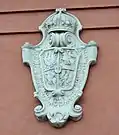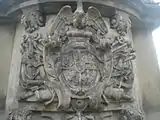Coat of arms of the Polish–Lithuanian Commonwealth
The coat of arms of the Polish–Lithuanian Commonwealth was the symbol of the Polish–Lithuanian Commonwealth, representing the union of the Crown of the Polish Kingdom and Grand Duchy of Lithuania.[1]
| Coat of arms of the Polish-Lithuanian Commonwealth | |
|---|---|
 | |
| Armiger | King of Poland/Grand Duke of Lithuania |
| Adopted | Following 1386[Note 1] |
| Blazon | Quarterly 1st and 4th Gules, an eagle argent, crowned or; 2nd and 3rd, Gules, Pogonia.[1][2][3][4] |
Modern reconstruction
 Grand coat of arms of the Polish–Lithuanian Commonwealth
Grand coat of arms of the Polish–Lithuanian Commonwealth Grand coat of arms of the Polish–Lithuanian Commonwealth
Grand coat of arms of the Polish–Lithuanian Commonwealth Coat of arms of the Polish–Lithuanian Commonwealth design during the House of Vasa reign
Coat of arms of the Polish–Lithuanian Commonwealth design during the House of Vasa reign
Background
The coat of arms of the Commonwealth combined the coat of arms of the Kingdom of Poland and the Grand Duchy of Lithuania, which are depicted as follows:
.svg.png.webp) Coat of arms of Poland, the White Eagle
Coat of arms of Poland, the White Eagle.svg.png.webp) Coat of arms of Lithuania, the White Knight
Coat of arms of Lithuania, the White Knight
During the Commonwealth, an inescutcheon contained the personal or family arms of the reigning monarch.
 Polish–Lithuanian coat of arms under King Henry
Polish–Lithuanian coat of arms under King Henry Polish–Lithuanian coat of arms under Vasa dynasty
Polish–Lithuanian coat of arms under Vasa dynasty%252C_1550-1609.jpg.webp) Polish–Lithuanian coat of arms under Vasa dynasty
Polish–Lithuanian coat of arms under Vasa dynasty 15 ducats of King Sigismund III Vasa from 1617
15 ducats of King Sigismund III Vasa from 1617![Polish–Lithuanian coat of arms under Michael I. Korybut coat of arms is placed in the escutcheon point.[citation needed]](../I/Coat_of_Arms_of_Michal_Korybut_Wisniowiecki_as_king_of_Poland.svg.png.webp) Polish–Lithuanian coat of arms under Michael I. Korybut coat of arms is placed in the escutcheon point.
Polish–Lithuanian coat of arms under Michael I. Korybut coat of arms is placed in the escutcheon point.![Polish–Lithuanian coat of arms under John III Sobieski. Janina coat of arms is placed in the escutcheon point.[citation needed]](../I/Coat_of_Arms_of_Jan_Sobieski_as_king_of_Poland.svg.png.webp) Polish–Lithuanian coat of arms under John III Sobieski. Janina coat of arms is placed in the escutcheon point.
Polish–Lithuanian coat of arms under John III Sobieski. Janina coat of arms is placed in the escutcheon point.%252C_1698.jpg.webp) Polish–Lithuanian coat of arms under John III Sobieski. Janina coat of arms is placed in the escutcheon point.
Polish–Lithuanian coat of arms under John III Sobieski. Janina coat of arms is placed in the escutcheon point.![Polish–Lithuanian coat of arms under Stanisław I. Wieniawa coat of arms is placed in the escutcheon point.[citation needed]](../I/Coat_of_Arms_of_Stanislaus_Leszczynski_as_king_of_Poland.svg.png.webp) Polish–Lithuanian coat of arms under Stanisław I. Wieniawa coat of arms is placed in the escutcheon point.
Polish–Lithuanian coat of arms under Stanisław I. Wieniawa coat of arms is placed in the escutcheon point. Polish–Lithuanian coat of arms under Wettin dynasty
Polish–Lithuanian coat of arms under Wettin dynasty Polish–Lithuanian coat of arms under Stanislaus II Augustus. Ciołek coat of arms is placed in the escutcheon point.
Polish–Lithuanian coat of arms under Stanislaus II Augustus. Ciołek coat of arms is placed in the escutcheon point.%252C_1764-1795.jpg.webp) Polish–Lithuanian coat of arms under Stanislaus II Augustus, 1764–1795
Polish–Lithuanian coat of arms under Stanislaus II Augustus, 1764–1795%252C_Polish_Eagle_and_his_personal_coat_of_arms%252C_1780.png.webp) Coat of arms of Stanislaus II Augustus, 1780
Coat of arms of Stanislaus II Augustus, 1780
Insurrections
During the January uprising a similar coat of arms was proposed for the restored Commonwealth, with Archangel Michael, the coat of arms of Ruthenia added as the third element. However, it was never officially introduced.
 Coat of arms for a proposed Polish–
Coat of arms for a proposed Polish–
Lithuanian–Ruthenian Commonwealth
The coat of arms in various cities
 Malbork Castle, Malbork, 1590s
Malbork Castle, Malbork, 1590s
 Royal Castle, Warsaw, 17th century
Royal Castle, Warsaw, 17th century Royal Castle, Warsaw, 18th century
Royal Castle, Warsaw, 18th century Royal Castle, Warsaw, 18th century
Royal Castle, Warsaw, 18th century Łazienki Park, Warsaw, 18th century
Łazienki Park, Warsaw, 18th century Henryk Sienkiewicz Monument, Łazienki Park, Warsaw, 20th century
Henryk Sienkiewicz Monument, Łazienki Park, Warsaw, 20th century%252C_from_the_headboard_of_the_sarcophagus_of_Sigismund_III_Vasa.jpg.webp) Wawel Cathedral, Kraków, 1633
Wawel Cathedral, Kraków, 1633 Wawel, Kraków
Wawel, Kraków Royal Chapel, Gdańsk, 1681
Royal Chapel, Gdańsk, 1681

 Dresden Cathedral, Dresden, 18th century
Dresden Cathedral, Dresden, 18th century
_2005.jpg.webp) Post milestone, Pirna, 1722
Post milestone, Pirna, 1722 Freiberg Cathedral, Freiberg, 18th century
Freiberg Cathedral, Freiberg, 18th century.jpg.webp) Post milestone, Lubań, 1725
Post milestone, Lubań, 1725 Moritzburg Castle, Moritzburg, 18th century
Moritzburg Castle, Moritzburg, 18th century Town hall, Wilsdruff, 18th century
Town hall, Wilsdruff, 18th century Catholic church, Nancy, 18th century
Catholic church, Nancy, 18th century.jpg.webp) Church of the Holy Spirit, Vilnius, 18th century
Church of the Holy Spirit, Vilnius, 18th century Palace of the Grand Dukes of Lithuania, Vilnius, restored in late 2010s
Palace of the Grand Dukes of Lithuania, Vilnius, restored in late 2010s%252C_and_initials_of_Augustus_II_the_Strong%252C_which_was_made_in_1703.jpg.webp) Palace of the Grand Dukes of Lithuania, Vilnius
Palace of the Grand Dukes of Lithuania, Vilnius Albertina, Vienna, 18th century
Albertina, Vienna, 18th century Theatine Church, Munich, 18th century
Theatine Church, Munich, 18th century Walderdorff Palace, Trier, 18th century
Walderdorff Palace, Trier, 18th century Guardhouse, Poznań, 1780s
Guardhouse, Poznań, 1780s.jpg.webp)
Wikimedia Commons has media related to Coats of arms of the Polish-Lithuanian Commonwealth.
Notes
- Adopted after the Union of Krewo, 184 years before the creation of the Commonwealth.
References
- Rimša, Egidijus. "Lietuvos valstybės herbas". Visuotinė lietuvių enciklopedija (in Lithuanian). Retrieved 22 May 2021.
- "History of the national coat of arms of Lithuania". Seimas. Retrieved 18 July 2021.
- "Double Cross". Seimas. Retrieved 18 July 2021.
- Herby Rzeczypospolitej Polskiej i Wielkiego Księstwa Litewskiego. Orły, Pogonie, województwa, książęta, kardynałowie, prymasi, hetmani, kanclerze, marszałkowie (in Polish). Jagiellonian Library. 1875–1900. pp. 6, 30, 32, 58, 84, 130, 160, 264, 282, 300. Retrieved 21 August 2021.
This article is issued from Wikipedia. The text is licensed under Creative Commons - Attribution - Sharealike. Additional terms may apply for the media files.
